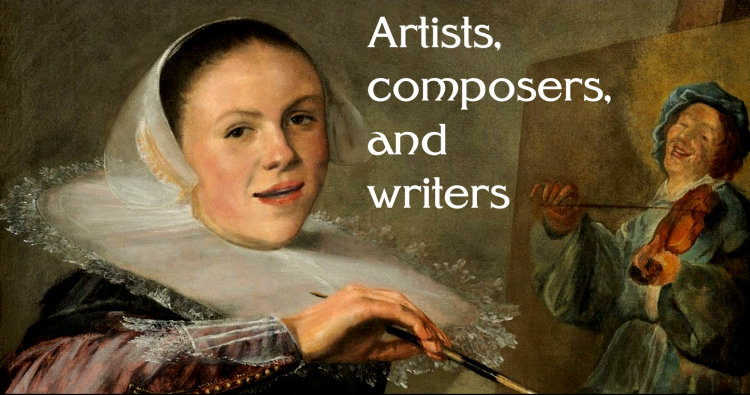3. Sensation and Idea.
The image above, the central portion of Giorgione's La tempesta painted in Venice around 1508, sums up the theme
of today's class. One characteristic of Italian Renaissance art, I would maintain, is the depiction of an idea or
ideal, rather than mere sensation; in Florentine art, especially, the first often eclipses the second. But
this picture comes from Venice, where the sensory world in all its aspects remained preeminent. We may no longer know
what idea Giorgione aimed to express in his enigmatic little painting, but we can have no doubt about its uncanny
atmosphere, sensual and disturbing at the same time.
The script, videos, and images will be posted immediately after class.
Here are brief bios of the artists and poets considered in the class, listed in chronological order of birth.
You can access all biographies via the BIOS link on the syllabus page.
 |
Simone Martini, 12851344. Sienese painter.
Martini was a friend of Petrarch and a leading exponent of the International Gothic style. "Perpetuating the Sienese tradition, Simone's style contrasted with the sobriety and monumentality of Florentine art, and is noted for its soft, stylized, decorative features, sinuosity of line, and courtly elegance." [Wikipedia] The self-portrait is conjectural.
|
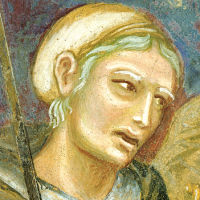 |
Ambrogio Lorenzetti, 12901348. Sienese painter.
He and his brother Pietro were among the leading masters of the 14th century. Ambrogio is especially noted for his frescoes of Good and Bad Government in the Palazzo Publico in Siena, remarkable for their naturalistic landscapes as much as their vigorous figures. [The self-portrait is conjectural]
|
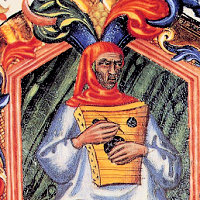 |
Lorenzo da Firenze, 130072. Italian composer.
He is represented in the Squarcialupi Codex, one of the principal sources for Italian music in the 14th century, by 16 pieces, but little is known about his life.
|
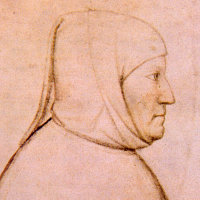 |
Francesco Petrarca (Petrarch), 130474. Italian poet.
A lyric poet and scholar, Petrarch's revival of interest in Roman literature is acknowledged as a foundation stone of the Renaissance.
|
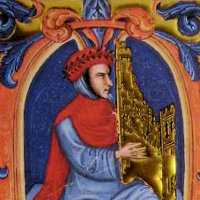 |
Francesco Landini, 132597. Florentine composer.
The leading Italian composer of the later 14th century, he was organist at various Florentine churches, and most probably a close friend of the poet Petrarch. Many of his secular songs have survived, but none of his sacred music.
|
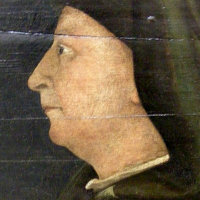 |
Filippo Brunelleschi, 13771446. Florentine architect.
One of the founding fathers of the Renaissance, he came to prominence as a sculptor in the competition for the Florence Baptistery doors, eventually won by Ghiberti. But it was as an architect that he made his biggest impression on the city, with the churches of San Lorenzo and Santo Spirito, and his crowning achievement, the dome of Florence Cathedral.
|
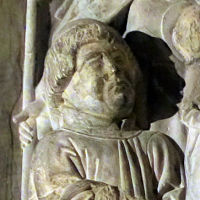 |
Guillaume Dufay, 13971474. Franco-Flemish composer.
Dufay (also spelled Du Fay and other variants) was born near Brussels. Writing in most genres and traveling widely, he was regarded as the leading composer of his time, composing for example a motet for the dedication of Brunelleschi's dome of Florence Cathedral. [The portait comes from his tomb.]
|
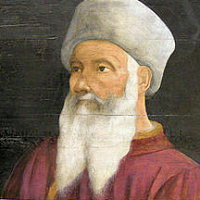 |
Paolo Uccello, 13971475. Italian painter.
With his interest in mathematics as well as art, Uccello was obsessed with perspective. He seldom used this to create an illusion of reality, however, but rather as an additional element in fanciful but dramatic paintings whose aesthetic is basically Gothic.
|
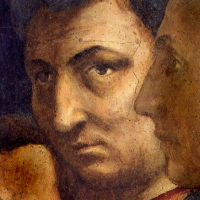 |
Masaccio (Tommaso di Ser Giovanni di Simone), 140128. Florentine painter.
Though he died at the age of 26, he brought about a revolution in painting and is one of the founding fathers of the Italian Renaissance. His finest work is probably the fresco cycle on the life of St. Peter in the Brancacci Chapel at Santa Maria Novella in Florence (142528), working alongside the painter Masolino; the names mean "big Tom" and "little Tom" respectively.
|
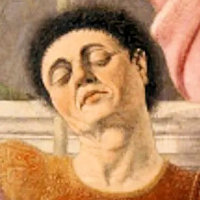 |
Piero della Francesca, 141592. Italian painter.
Born in Borgo San Sepolcro in Umbria, he also worked in Arezzo, Urbino, and elsewhere. Though virtually forgotten after his death, he has been reappraised in the 20th century as filling the gap between the early and High Renaissance. Intensely interested in perspective, his work has a mathematical rigor that adds tautness to his often unconventional compositions, and his gift for color is matched by few others of his time. The self-portrait is conjectural.
|
 |
Giovanni Bellini, 14351516. Venetian painter.
One of a family of artists, he more than anyone was responsible for developing the characteristic Venetian style of painting in layers of oils, no doubt learned from the Flemish masters. This gives his pictures their extraordinary light, whether portraits or religious subjects.
|
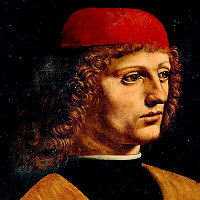 |
Josquin des Prez, 14401521. Franco-Flemish composer.
Josquin is considered one of the leading composers in the High Renaissance, and not just in the Franco-Flemish school. Almost all his works are vocal, mostly sacred. He is credited with breaking away from the tradition of long melismatic lines, writing instead in short imitative phrases that are closely expressive of the text. [This portrait of a musician by Leonardo da Vinci has not definitely been identified as Josquin, although both were in Milan at the same time.]
|
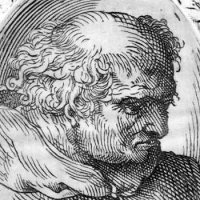 |
Donato Bramante, 14441514. Italian architect.
Born near Urbino in central Italy, Bramante worked first in Milan, then moved to Rome in 1499. His tiny Tempietto (1510), built on the spot where St. Peter was crucified, epitomizes the perfection of the High Renaissance. From small scale to large, Julius II engaged him as architect for the new St. Peter's, and his plans underlie all subsequent designs, but he died long before they could be completed.
|
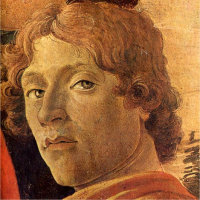 |
Sandro Botticelli, 14451510. Italian painter.
Botticelli's work was neglected for centuries, but he is now acknowledged as the leading Florentine painter of the later quattrocento. Although he produced numerous religious paintings, he is best known for two large mythological works: Primavera (c.1480) and The Birth of Venus (c.1485).
|
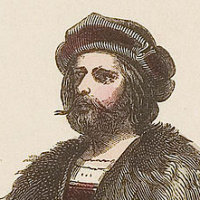 |
Pierre de la Rue, 14521518. French composer.
Born in and working largely in Flanders, De la Rue is known to have traveled to France, Spain, and England, but probably not to Italy, although his music was well known there. This makes him highly unusual among Franco-Flemish musicians of his generation who, like Josquin des Prez, enjoyed a comparable international reputation.
|
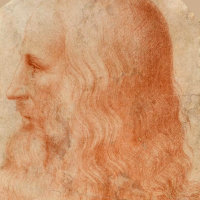 |
Leonardo da Vinci, 14521519. Italian painter and polymath.
With Michelangelo and Raphael, one of the triumvirate of artistic geniuses that crown the High Renaissance. He trained in Florence with the painter Andrea Verrocchio before moving to the court of Ludovico Sforza in Milan. He spent the last years of his life at the court of Franηois I in France. The naturalism and luminosity of his painting, and his effects of sfumato (or modeling as if by smoke), were widely influential. It is his notebooks, however, that are the best testament to the range of his genius, containing remarkable observations of the natural world, and mechanical inventions centuries before their time.
|
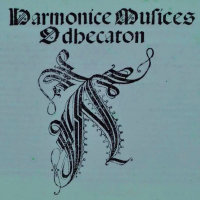 |
Ottaviano Petrucci, 14661539. Italian publisher.
Petrucci's Harmonice Musices Odhecaton, (100 songs of harmonic music), a collection of chansons printed in 1501, is considered the first polyphonic music printed with movable type. Most of the pieces it contains are by Franco-Flemish composers.
|
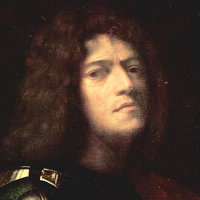 |
Giorgione (Giorgio da Castelfranco), 14771510. Venetian painter.
Almost nothing is known of his life, and the catalogue of his undisputed works is very small, his fame and influence are quite disproportionate to the size of his output. He was an exquisite colorist, the first to specialize in cabinet paintings for private patrons rather than religious commissions, and the first painter to subordinate subject matter to the evocation of mood.
|
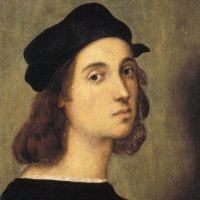 |
Raffaello Sanzio (Raphael), 14831520. Italian painter and architect.
One of the towering geniuses of the Italian Renaissance, Raphael was born in central Italy, and worked there until 1508, when he moved to Rome to decorate several stanze in the Vatican for Pope Julius II, and later his successor Leo X. The influence of these and other works of the period can be seen in religious art for many centuries to come. He was also one of the many architects of St. Peters.
|
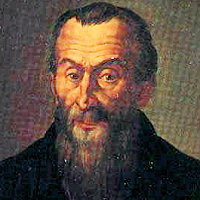 |
Adrian Willaert, 14901562. Netherlandish composer.
Willaert's music traveled to Italy before he hiself did, at the age of 25. But that was where he spent the rest of his career, in court appointments in Ferrara and Milan, and latterly as maestro di cappella of St. Mark's at Venice, becoming the founder of an important musical tradition that was to last through the 17th century. He also composed many secular compositions to Italian texts.
|
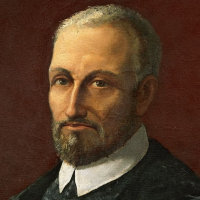 |
Giovanni Pierluigi da Palestrina, 152594. Italian composer.
Born near Rome, he was active in Roman churches almost all his life, first as chorister and then as choirmaster. His large output was mainly of sacred music (for example, 105 masses) though he also wrote secular madrigals. His multi-voice contrapuntal style is considered the culmination of renaissance polyphony.
|
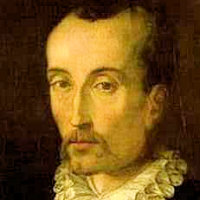 |
Giaches de Wert, 153596. Franco-Flemish composer.
Born in Flanders, Wert went to Italy as a choirboy and remained there the rest of his life, working mainly for the Gonzaga court in Mantua and the Este court in Ferrara. He played an important part in the development of the madrigal in Italy in the generation befoe Monteverdi.
|
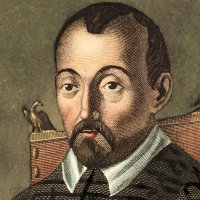 |
Giovanni Battista Guarini, 15381612. Italian poet.
"No poet played a larger role in the flowering of the madrigal in the late Renaissance and early Baroque eras than Guarini. His poems were set more often by madrigal composers than the work of any other." [Wikipedia]
|
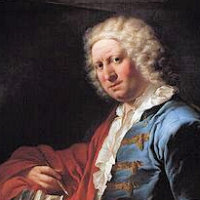 |
Giovanni Paolo Panini, 16911765. Italian painter and decorator.
As a painter, the Piacenza-born Panini specialized in vedute, views of Rome and similar sites, often involving free rearrangement of the buildings to support a theme. He was also an interior decorator of palaces and occasional architect.
|






















































